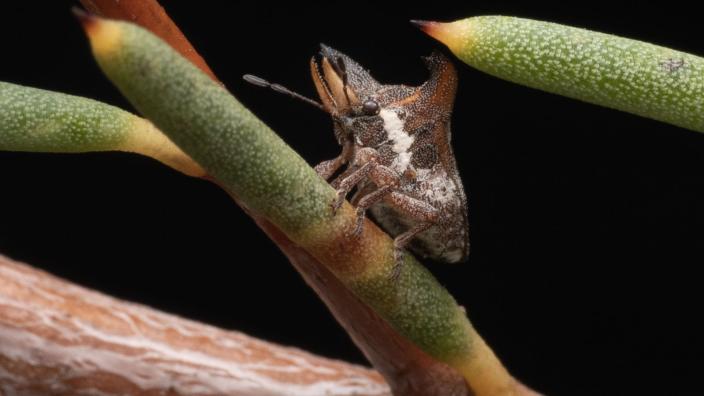Entomologists from the Western Australian Museum and University of New South Wales have made the fascinating discovery of a stink bug species that is believed to be new to science, during a two-week Bush Blitz expedition near Kepa Kurl (Esperance) in Western Australia.
The currently unclassified bug, measuring around the size of a pea, has two curved horns as well as bright yellow tusks and was found camouflaged on a local Hakea species of plant.
Discovered with the help of the Tjaltjraak Rangers and Senior Cultural Advisor Doc Reynolds at a place of cultural significance to the Wudjari people of the region the expedition was part of the Bush Blitz program.
WA Museum Curator of Entomology Dr Nikolai J Tatarnic said although the team have found eight new bug species on this trip, this stink bug is the most interesting of all.
“Only the males have the tusks and we don’t know what they’re for yet. They could be for courtship, or they could be used to lever other males off the plant as they compete for females,” he said.
“It could be the males with the largest tusks are the ones to successfully mate, but we won’t know without further study."

The unclassified tusked stink bug
Image copyright WA Museum
The Kepa Kurl - Tjaltjraak Boodja (Esperance) WA Bush Blitz is the program’s 48th expedition and involved Parks Australia staff and 15 scientists including botanists from WA Herbarium, zoologists from the Western Australian Museum, Northern Territory Museum and Art Gallery, Griffith University, University of New South Wales and the Australian Museum.
Tjaltjraak Rangers and Senior Cultural Advisors worked alongside the scientific team, sharing their invaluable knowledge of the area and helping to discover the new species.
University of NSW Systematic Entomologist Dr Gerry Cassis said the discovery of this stink bug highlights how little we know of insects in Australia, with only 30 per cent of species known.
“This stink bug has never been classified before and is new to science. Under a microscope you can clearly see a pair of huge projections on the side of the thorax that makes them blend in with their shrub host plants,” he said.
“Its restriction to the Esperance region also demonstrates the hyperdiversity of insects in Western Australia.”
Five science teachers also joined the expedition; each selected as part of the Bush Blitz TeachLive program. Since Bush Blitz’s inception in 2010 it has discovered more than 1,850 plant and animal species new to science including frogs, reptiles, snails, fish, spiders, marine invertebrates and insects. Bush Blitz is a partnership between the Australian Government through Parks Australia, BHP and Earthwatch Australia.